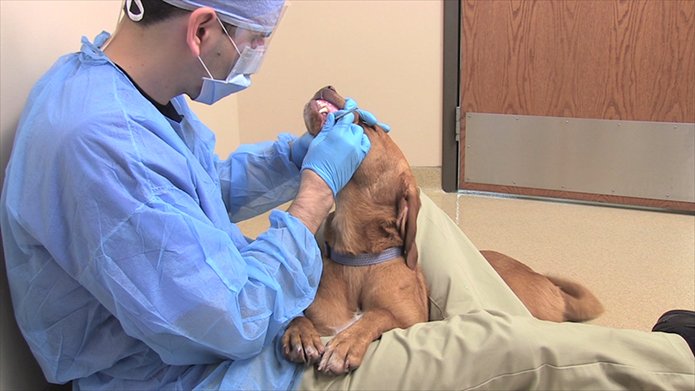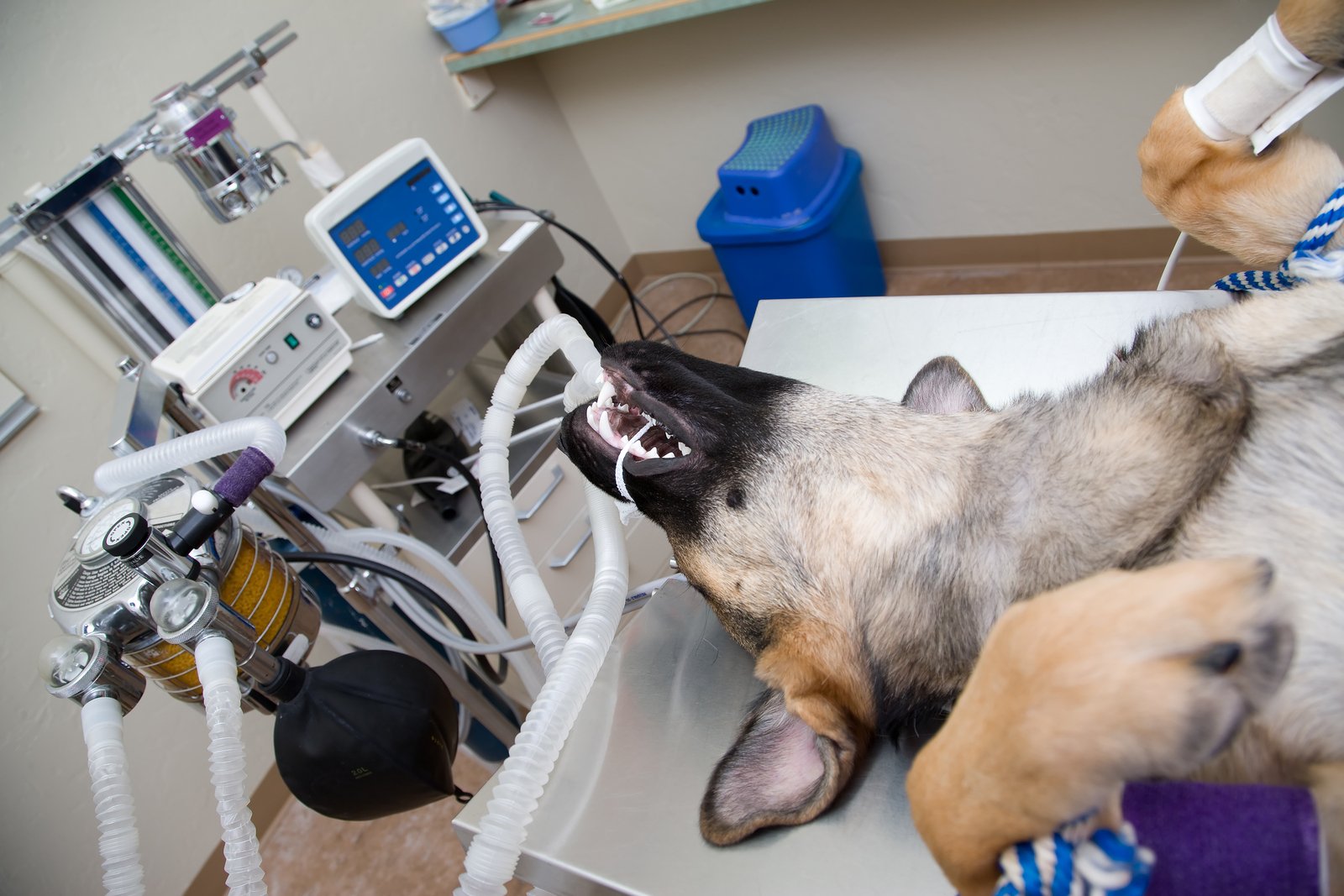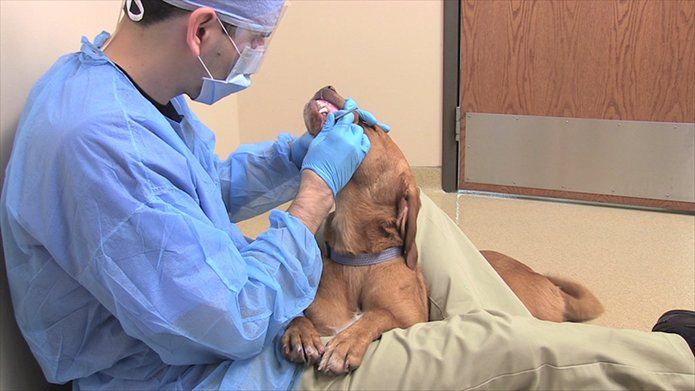Animal Dental Care


We frequently remind our readers that dogs need to be anesthetized when having their teeth cleaned because our pets “do not sit still and open wide.” In fact, we said it as recently as our July issue.
That prompted Your Dog reader Pamela Skinner of Goshen, Massachusetts, to write in. A couple of her own dogs had already undergone anesthesia-free dental cleanings, with results she was very happy with.
“Our veterinary practice has begun using an outside service for routine cleanings,” she said. “The advantages are that it’s fast (30 minutes), less expensive (since anesthesia isn’t involved), and works well for many dogs.
“We scheduled two of our dogs for cleanings recently and were delighted with the results: clean, tartar-free, stain-free pearly whites!”
We followed up with Ms. Skinner in a phone conversation, during which she said, “the back story is really interesting, too. Apparently, our practice has left the American Animal Hospital Association [AAHA]. The association had been credentialing them for 30 years. They wrote a long letter to AAHA, which does not endorse this practice.”
The American Animal Hospital Association sets standards and “best practices” for small animal veterinary practices. It accredits animal hospitals based on a set of approximately 900 standards of veterinary excellence. Cleaning dogs’ teeth without anesthesia, it turns out, is not one of them.
Bigstock


Arguments against anesthesia-free teeth cleanings…
Katherine Wessels, Senior Communications Manager for the American Animal Hospital Association, told us in an e-mail exchange that the AAHA Dental Care Guidelines for Dogs and Cats state that “cleaning a companion animal’s teeth without general anesthesia is considered unacceptable and below the standard of care. The reasoning behind this is that general anesthesia with intubation [which protects the trachea and prevents aspiration of water and oral debris] is necessary to properly assess and treat the companion animal dental patient. The use of general anesthesia allows for the necessary immobilization without discomfort.”
She also said that it allows for the necessary probing of the gums to see if there is gum disease (the most common clinical condition affecting adult dogs), mouth x-rays that capture what the naked eye cannot (and for which a dog has to be completely still), and the removal of plaque and tartar not only above but also below the gum line “to ensure patient health and safety.” She added that “at least 60 percent of…dogs’ normal tooth structure is under the gum line; partially removing plaque and tartar only from the exposed crown [the part of the tooth that people can see] is more cosmetic than therapeutic. Removing the plaque and tartar from both above and below the” gum line requires general anesthesia and results in a cosmetic as well as therapeutic outcome. General anesthesia,” she said, “also…keeps practice teams safe from potential bites.”
The American Veterinary Dental College weighs in
The American Veterinary Dental College, the body that provides board certification to veterinarians who have gone on to specialize in dentistry and have passed both training requirements and a qualifying exam, agrees with the American Animal Hospital Association. In fact, on its home page (AVDC.org,), it even has a section called “Anesthesia Free Dentistry; Know the Facts.”
Here’s one of them, according to the AVDC: “At the end of the anesthesia free dental procedure, the outside surfaces on your pet’s teeth may appear visibly whiter. However, there is much more than meets the eye.”
The organization continues: “Scaling (scraping the surface of the tooth with an instrument) the plaque and tartar from the outside surfaces of the teeth does not remove the plaque and bacteria from beneath your pet’s gumline and does not decrease the risk of your pet getting periodontal disease. Consider this: the same level of ‘gross’ build up you see on your pet’s teeth, is also thriving beneath their gumline where you can’t see it or the damage it’s doing. Cleaning and scaling below the gum line is most important because it’s where periodontal [gum] disease is most active. This can’t be done without anesthesia.” The organization adds that when cleaning does not occur beneath the gumline, extensive damage to tooth roots and the supporting bone structure can occur.
“White teeth do not mean a clean and healthy mouth,” the American Veterinary Dental College sums up. “This is the most unfortunate misconception by many loving pet owners, who don’t realize the potential oral health problems that sit beneath their pet’s gums.”
The American Veterinary Dental College also points out the distress that teeth cleaning without anesthesia can put a dog through. “While some pets may appear to tolerate this restraint better than others,” it says on its site, “your pet is still being restrained for a lengthy period of time with no ability to understand why or what is happening to them.
“How many people actually enjoy sitting in the dental chair, holding their mouth open while a dental hygienist scrapes mineralized tartar from their teeth? Imagine how a pet, who can’t communicate, feels when the…provider holds open their mouth and attempts to do the same. We can understand what the dentist or hygienist is doing and can be asked to hold still and relax, but the pet does not understand and thus will frequently require a traumatic restraint process.
“The next step is using a sharp instrument to remove plaque from the visible part of the tooth….
“Consider your visits to the dentist and the minor scaling that sometimes has to be done to remove some of the tiny spots of plaque build-up. Now, take a look at your pet’s teeth and think about how it might feel to have that amount of build-up scraped from your teeth. It certainly could cause a great deal of discomfort and pain to your pet.”
…and arguments for anesthesia-free dental cleanings
Veterinarian Ellie Shelburne, DVM, a co-owner of Northampton Veterinary Clinic, the practice where Ms. Skinner brings her dogs for anesthesia-free dental cleanings, agrees that cleanings while the dog is awake have a number of limitations. “We have not substituted this for dentistry,” she says. “It’s more of a supplement, another tool in our box to help provide excellent dental care. We do full-mouth dental x-rays and extensive dental work here.”
It’s not even for all routine cleanings, Dr. Shelburne says. “We grade tartar [hardened plaque that contributes to gum disease] from a one-out-of-four to a four-out-of-four,” with a four being the worst. “We only recommend” dental cleanings without anesthesia “for a one — minimal tartar, with just a millimeter of tartar below the gum line, which our clinical experience shows the technician can reach without anesthesia. This is not for a dog with overt periodontal disease.”
If a dog does have a “one,” a technician from an outside company who periodically comes in to the office is assigned to remove the tartar from the pet’s mouth. The cost is considerably lower than the cost of a veterinarian putting a dog under anesthesia and doing the cleaning herself.
“We have used it quite effectively on high-risk anesthesia patients,” Dr. Shelburne says. “Removal of tartar can take 45 minutes to an hour under anesthesia. If we can get started without it and then have the client come back in a few days, we’ll do the rest of the cleaning under anesthesia but reduce total anesthesia time.” Once the dog is under, she adds, her practice will take a set of x-rays and do deeper probing under the gum line to check for problems that the technician wasn’t able to while the dog was awake.
But sometimes, Dr. Shelburne comments, even the technician cleaning the dog’s teeth without anesthesia will find problems — a tooth separating from the gum because of gum disease, some other issue — that requires dentistry under anesthesia. “Then we convert to full dental with anesthesia,” she says.
Once the dog is under, she or another veterinarian in her practice can take full-mouth x-rays and determine from there what to do. “We might have to extract a tooth,” she says, “or go under the gum to apply an antibiotic that sits in there and helps fill pockets and regenerate the bone.” In that way, the anesthesia-free cleanings become “an ancillary tool for us. They don’t replace full dentistry.”
Kate Knutson, DVM, whose practice is limited almost exclusively to dental patients, also extols the benefits of anesthesia-free dental cleanings. She speaks of a “little 15-year-old named Sydney — a mutt — who, not under anesthesia, was found to have a big change in one of her teeth when she was being probed for gum disease. There was a much bigger “pocket” between the gum and the tooth than there had been not long before. That was a red flag that led Dr. Knutson to put Sydney under anesthesia for a better look, and it turned out the change by the tooth was the result of “a tumor in the bone around the tooth — melanoma, a very aggressive and serious tumor.”
Dr. Knutson took the tumor out, saying that without the anesthesia-free dental procedure, “we never would have found” it in time to remove it. “It would have been two or three months later when she came in for her usual dental cleaning and examination under anesthesia, “but the tumor would have been a lot bigger by then” and very probably not able to be treated successfully.
“That’s how” anesthesia-free cleanings “can be used as early detection,” Dr. Knutson says. “We need to have all sorts of different modalities in our tool box.”
Dr. Knutson feels so strongly about anesthesia-free dental cleanings that she has done an about-face in her thinking. She used to be the president of the American Animal Hospital Association, believing that dogs always had to be put under for dental cleanings if for no other reason than that the veterinarian could then take full-mouth x-rays. But one of the two big companies in the U.S. that trains technicians to perform anesthesia-free cleanings — American Dental Care — implored her to come watch such a cleaning in action, and she had “a moment where I was nauseous. I went, ‘Oh my God, they’re doing it so well, and they are so good, I would hire them at my own hospital.’ And then I went to other veterinary practices around the country,” she says, “and knew that my position had been wrong. Even when I think about it now, the fact that I was on the AAHA board when mandatory anesthesia for dental work was made a standard does not bring a good feeling to me.”
Today, Dr. Knutson is on the board of American Dental Care. She feels that strongly about the value of their work.
American Dental Care is the company that Dr. Shelburne uses in her own practice. And she notes that anesthesia-free dental cleanings actually increase the dentistry her patients do receive under anesthesia because clients who might not have been comfortable letting their dogs receive anesthesia will be more ready to do so if the vet tells them a specific problem was found rather than just recommends anesthesia for a routine cleaning and exam. “It brings dentistry into the forefront a little more,” she says. “It’s very rare to find a problem and have a client say, ‘No, we can’t do it.’ We actually do more anesthesia dentals because of this. We end up providing better care to more” dogs.
Along with being glad that anesthesia-free cleanings “help clients get comfortable with veterinary dentistry,” Dr. Shelburne likes that the technicians coming in from the outside company “do an outstanding job of teaching people how to do home care.”
Adds the doctor, “what I’m hearing mostly from veterinary dentists” is that with anesthesia-free cleanings, “you’re missing things under the gums, and I don’t completely disagree.” But based on dogs she has put under anesthesia after their teeth have been cleaned without it, she has not been seeing a lot that the technicians have missed in their work. “I want to see the statistics” on what gets missed with anesthesia-free cleanings, she says, “which nobody has.” Studies need to be done.
Even with that, Dr. Shelburne emphasizes that she is “not trying to replace anesthesia” for dogs who need teeth cleanings. Anesthesia-free dental cleanings are in fact “a very small portion of supportive care for dental work” performed in her office. Most of the time,” she says, “clients opt for these in between the real dental treatments.”
Another take
Despite the good experiences some veterinarians have had with anesthesia-free cleanings, William Rosenblad, DVM, an editorial advisory board member for Your Dog who completed a residency in veterinary dentistry and is on the dental team at Angell Animal Medical Center in Boston, is decidedly against the practice. “I am in total agreement with the American Animal Hospital Association and the American Veterinary Dental College,” he says.
One reason he cites is that “even in cooperative patients, even slight head or mouth movements could lead to damage to the gum tissue from dental instruments, and then the gingival [gum] recession is permanent, potentially increasing future periodontal disease.”
He also points out that “improper irrigation during and after cleaning and polishing could lead to aspiration (not to mention the possibility of pieces of calculus [tartar] ending up in the respiratory tract), one great advantage of having an intubated patient [under anesthesia].”
Dr. Rosenbald is also concerned with the training of the technicians who do the work. “One major proponent of anesthesia-free dentals says that these technicians are trained to perform proprietary patient-holding techniques that ‘include complete control over the gag reflex.’ That should frighten any veterinarian and pet owner,” he comments “Between being a tech and then a veterinarian, I have been in the veterinary business for 40 years and cannot believe that there are safe ways to hold veterinary patients of which I am unaware. No technique I have ever used or been taught included controlling a pet’s gag reflex!”
Adds Dr. Rosenblad, “the false sense of security that these procedures provide might be the worst aspect of them. Some of the companies that provide this service say that they do refer for an anesthetized dental procedure when they find” disease. But how much can we rely on disease “detected by a technician trained for several months” as opposed to a veterinarian trained for many years? Furthermore, he notes, “there are a couple of studies showing that more than 25 percent of dental pathology goes undetected until noted on radiographs [x-rays].” Given those study results, “the vast majority of patients would just benefit from getting a proper dental procedure under anesthesia at appropriate intervals with daily tooth brushing, dry food, and appropriate crunchy treats between procedures.” For dog owners afraid of anesthesia, Dr. Rosenblad adds that “properly performed anesthesia is safer than the progression of [dental] disease,” which can cause bone loss and tooth loss, along with other problems.
Take-away points
As Dr. Knutson puts it, the disagreement on whether to be for “Clinton or Trump is mild compared to” the disagreement on whether to embrace anesthesia-free dental cleanings. Even among people in the same camp, the agreement is not 100 percent. For instance, she believes that anesthesia-free cleanings can get to worse cases of tartar, further under the gum line, than Dr. Shelburne does, although she points out that in general, peer-reviewed studies are needed to make a true scientific comparison between cleanings done under anesthesia and cleanings performed without it.
To help put things in perspective for how to think about your dog’s oral health in the here and now, here are some things on which veterinary dentists on both sides of the argument are agreed.
1. Anesthesia-free dental cleanings cannot and never will be able to take the place of dental exams performed with the dog under anesthesia. Only with anesthesia can a dog have dental x-rays, which are the only tool for a veterinarian to actually see under the gum line and determine whether there’s a problem that needs to be tended to. (Unfortunately, says Dr. Knutson, less than 9 percent of veterinary hospitals in the U.S. have the capability to take full-mouth x-rays.)
2. Serious dental problems can only be addressed with a dog who is under anesthesia.
3. Anesthesia is safe for the vast majority of dogs, including old dogs.
4. While anesthesia-free dental cleanings may make some dog owners more comfortable about getting their pets dental care (and that’s certainly not a bad thing), appropriate health screenings for a dog include regularly scheduled oral exams by a veterinarian and, as the dog ages, regularly scheduled cleanings while the dog is under anesthesia.





